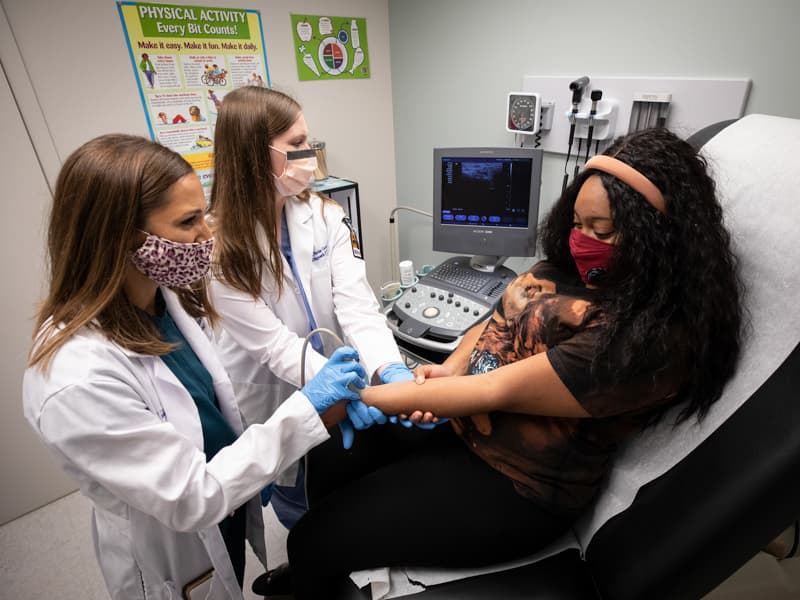Navigating the World of Radiology: Careers, Salaries, and Surgical Support
Radiology technologists, also known as radiographers, provide technical support in the field of radiology and ultrasound. They play a crucial role in performing various imaging procedures, such as X-rays and ultrasound scans.
In Austin, Texas, United States, radiology technologists earn a competitive salary while assisting in surgeries and working closely with surgical technologists. Ultrasonography is a specialized area within radiology, where technicians use sound waves to create images. X-rays and ultrasounds are both commonly used diagnostic imaging techniques that help healthcare professionals diagnose and treat medical conditions.
We will explore the roles of radiology technologists, the differences between X-ray and ultrasound technicians, and the salary expectations for this field.

Credit: www.bartonhealthcarestaffing.com
Introduction To Radiology
Discover the world of radiology, where radiographers provide technical support in surgery using ultrasonography, x-rays, and ultrasound. Learn about their salaries and the fascinating field of surgical technology.
Radiology is a branch of medicine that utilizes medical imaging techniques to diagnose and treat various diseases and conditions. It plays a crucial role in modern healthcare, enabling medical professionals to visualize and evaluate internal structures of the human body.
Radiology employs advanced technologies such as X-rays, ultrasound, and magnetic resonance imaging (MRI) to produce detailed images that aid in accurate diagnoses and guide surgical interventions.
How Radiology Works
- X-Rays: X-ray imaging uses electromagnetic radiation to capture images of bones and tissues. It is commonly used to diagnose fractures, lung diseases, and infections.
- Ultrasound: Ultrasound imaging utilizes sound waves to create real-time images of organs, blood vessels, and tissues. It is frequently used for monitoring fetal development, diagnosing abdominal conditions, and guiding surgical procedures.
- MRI: Magnetic resonance imaging utilizes powerful magnets and radio waves to generate detailed images of internal body structures. It is particularly effective in visualizing soft tissues and the central nervous system.
The Role Of Radiographers And Surgical Technologists
- Radiographers: Radiographers, also known as radiologic technologists, are highly trained healthcare professionals who operate the equipment and perform the imaging procedures. They play a crucial role in ensuring patient safety, positioning patients correctly, and capturing high-quality images for diagnosis.
- Surgical Technologists: Surgical technologists are essential members of the surgical team who assist surgeons during operations. They prepare and sterilize instruments, help with patient positioning, and handle imaging equipment such as X-rays and fluoroscopy during surgical procedures.
Salary And Career Opportunities
- Radiographers: Radiographers enjoy competitive salaries, with the average annual wage in the United States ranging from $50,000 to $70,000. Salaries may vary depending on factors such as experience, location, and specialization.
- Surgical Technologists: Surgical technologists also have promising career prospects, with an average annual salary ranging from $40,000 to $60,000. The demand for surgical technologists is expected to grow due to the increasing number of surgeries performed each year.
Radiology is a vital field in medicine that encompasses various imaging techniques to diagnose and treat diseases and conditions. Radiographers and surgical technologists play integral roles in performing imaging procedures and assisting during surgical interventions. With competitive salaries and promising career opportunities, these professionals contribute significantly to the healthcare industry.
Roles In Radiology
Radiology plays a crucial role in healthcare, with radiographers and technical support providing essential services such as ultrasonography, X-rays, and ultrasounds. With competitive salaries and opportunities to work in surgery alongside surgical technologists, this field offers a rewarding career path.
Radiology is a field of medicine that specializes in using medical imaging technologies to diagnose and treat various conditions. Within the field of radiology, there are different roles and specializations that play crucial roles in the healthcare system. Let’s take a closer look at some of these roles:
Radiologist:
- A radiologist is a medical doctor who interprets and analyzes medical images, such as X-rays, CT scans, MRIs, and ultrasounds.
- They work closely with other healthcare professionals to provide accurate diagnoses and treatment plans.
- Radiologists are experts in identifying abnormalities in images and determining the best course of action for patients.
Radiologic Technologist:
- Radiologic technologists, also known as radiographers, are responsible for operating imaging equipment and performing diagnostic scans on patients.
- They handle various imaging techniques such as X-rays, CT scans, and mammographies.
- Radiologic technologists ensure patient safety, position patients correctly for scans, and assist radiologists in obtaining high-quality images for accurate diagnoses.
Sonographer:
- Sonography, also known as ultrasound imaging, is a non-invasive imaging modality that uses sound waves to produce images of internal organs and structures.
- Sonographers specialize in performing ultrasound examinations and are skilled at capturing detailed images of the body’s anatomical structures, including organs, blood vessels, and developing fetuses.
- They work closely with radiologists, providing them with the necessary images to aid in diagnosis and treatment planning.
Magnetic Resonance Imaging (Mri) Technologist:
- MRI technologists specialize in operating MRI equipment, which uses powerful magnets and radio waves to produce images of the body’s organs and tissues.
- They play a vital role in obtaining clear and accurate images that help radiologists diagnose and monitor a wide range of conditions.
- MRI technologists ensure patient safety during scans and maintain the equipment to ensure optimal performance.
Surgical Technologist:
- Surgical technologists are essential members of the surgical team who assist surgeons and nurses during surgical procedures.
- They prepare the operating room, arrange surgical equipment, and ensure a sterile environment.
- In radiology, surgical technologists may assist during interventional radiology procedures, where radiologists use imaging guidance to perform minimally invasive treatments.
Technical Support In Radiology:
- Technical support professionals in radiology play a critical role in maintaining and troubleshooting radiological imaging equipment.
- They ensure that all imaging systems are functioning correctly and available for use by radiologists and technologists.
- Technical support professionals provide technical assistance and expertise to ensure accurate and efficient imaging operations.
Radiology offers diverse career opportunities, each playing a crucial role in the diagnosis, treatment, and management of various medical conditions. Whether it’s interpreting images, performing scans, or providing technical support, these professionals contribute to improving patient outcomes and overall healthcare delivery.
Becoming A Radiographer
Becoming a radiographer offers a rewarding career in the medical imaging industry, where you can specialize in various modalities such as X-ray, ultrasound, and surgical technologist. With competitive salaries and technical support, this field provides opportunities for growth and professional development.
Radiographers play a critical role in the field of healthcare by using various imaging technologies to assist in diagnosing and treating medical conditions. If you have an interest in the medical field and enjoy working with technology, becoming a radiographer may be a rewarding career option for you.
Here are some key points to consider if you’re interested in pursuing a career as a radiographer:
- Education and Training: To become a radiographer, you’ll need to complete an accredited radiography program. These programs typically result in an associate’s or bachelor’s degree and include a mix of classroom instruction and hands-on clinical experience.
- Specializations: Radiographers can specialize in various areas of medical imaging, such as X-ray, ultrasound, MRI, and CT scans. Each specialization requires additional training and certification beyond the basic radiography program.
- Licensing and Certification: Once you’ve completed your education and training, you’ll need to obtain the necessary licenses and certifications to practice as a radiographer. The requirements vary by state, so it’s important to research the specific requirements for the state in which you plan to work.
- Skills and Traits: Successful radiographers possess strong technical skills, attention to detail, and excellent communication skills. They must be able to operate imaging equipment accurately and safely, as well as effectively communicate with patients to ensure their comfort and cooperation during procedures.
- Job Outlook and Salary: The job outlook for radiographers is promising, with steady job growth projected in the coming years. According to the Bureau of Labor Statistics, the median annual wage for radiologic technologists was $62,280 as of May 2020.
- Continuing Education: The field of radiography is constantly evolving, with new technologies and techniques being introduced regularly. Therefore, it’s important for radiographers to engage in continuing education to stay up-to-date with the latest advancements in the field.
Becoming a radiographer can open doors to a rewarding career in the medical field. By completing the necessary education and training, obtaining the required licenses and certifications, and continuously expanding your knowledge, you can thrive in this ever-growing profession.
Surgical Technologists In Radiology
Surgical technologists play a crucial role in radiology departments, providing technical support during surgeries and assisting radiographers in performing procedures like ultrasonography and X-rays. With a competitive salary and the opportunity to work in a dynamic surgical environment, surgical technologists are vital members of the healthcare team.
Surgical technologists play a crucial role within the field of radiology. They work closely with radiologists and other medical professionals to assist in surgical procedures involving imaging technology. Here are some key points about surgical technologists in radiology:
- Surgical technologists are specialized healthcare professionals who prepare operating rooms and equipment for surgical procedures.
- They work alongside radiologists and perform tasks such as positioning patients, operating imaging equipment, and assisting during procedures.
- Surgical technologists in radiology must have a strong understanding of various imaging modalities, including X-rays, ultrasounds, and MRIs.
- They ensure that patients are properly positioned to obtain the necessary images, follow safety protocols, and maintain sterile environments in the operating room.
- Surgical technologists in radiology also assist with patient care, including monitoring vital signs and providing support before, during, and after surgeries.
- These professionals require excellent communication and teamwork skills to collaborate effectively with the surgical team and radiologists.
- Surgical technologists in radiology often work in hospitals, outpatient care centers, and ambulatory surgical centers.
- They typically complete a surgical technologist training program and obtain certification to practice in their respective fields.
Surgical technologists in radiology play a vital role in assisting radiologists in surgical procedures involving imaging technology. They ensure the smooth operation of the operating room and contribute to the accurate capture of diagnostic images for the benefit of patients.
Radiology And Surgery
Radiology and surgery are two essential components of the medical field. Radiology involves the use of imaging techniques such as X-rays and ultrasound to diagnose and treat various conditions. Surgery, on the other hand, is a medical specialty that focuses on performing procedures to treat diseases or injuries.
Both radiology and surgery play crucial roles in providing patients with accurate diagnoses and effective treatments.
Radiology and surgery are two distinct fields in the medical industry, each playing a crucial role in patient care. Let’s take a closer look at what radiology and surgery entail:
Radiology:
- Radiology focuses on using medical imaging technology, such as x-rays, ultrasound, and MRI, to diagnose and treat diseases and injuries.
- Radiologists are specialized doctors who interpret the images obtained through various imaging techniques.
- Radiology technologists, also known as radiographers, are skilled professionals who perform the imaging tests under the guidance of radiologists.
- Radiology technologists operate the equipment, position patients correctly, and ensure accurate image quality.
- They also prepare patients for procedures and provide necessary support during imaging tests.
- Radiology offers a non-invasive way to detect and monitor health conditions, allowing for timely intervention and effective treatment plans.
Surgery:
- Surgery involves the physical intervention in a patient’s body to treat diseases, injuries, or deformities.
- Surgeons are highly trained medical professionals who specialize in performing surgical procedures.
- Surgical technologists play a vital role in the operating room by providing technical support to the surgical team.
- They assist surgeons by preparing the operating room, sterilizing equipment, and handing instruments during surgical procedures.
- Surgical technologists ensure a safe and sterile environment in the operating room, minimizing the risk of infections and complications.
- Surgery requires precise skills, attention to detail, and a collaborative approach among the entire surgical team.
Radiology focuses on utilizing medical imaging technology to diagnose and treat diseases, while surgery involves the physical intervention in a patient’s body to provide treatment. Both fields are essential for comprehensive patient care and require skilled professionals to ensure accurate diagnoses and safe surgical procedures.
The Importance Of Technical Support
Technical support plays a crucial role in the field of radiology and ultrasonography by ensuring the smooth operation of equipment, assisting radiographers and surgical technologists, and troubleshooting any technical issues that may arise. It is essential for maintaining the efficiency and accuracy of diagnostic procedures in radiology and surgery.
Technical support plays a vital role in the field of radiology and surgical technology. Whether it’s assisting with complex imaging equipment or troubleshooting issues during surgeries, technical support ensures smooth operations and accurate diagnoses. Here are some key points to understand the importance of technical support:
- Equipment Maintenance: Technical support professionals are responsible for the regular maintenance and calibration of radiology and surgical equipment. This ensures that the machines are in optimal condition and produce accurate results.
- Troubleshooting: In the event of equipment malfunctions or technical difficulties, technical support specialists are trained to quickly identify and resolve issues. Their expertise helps to minimize downtime and prevent delays in patient care.
- Quality Control: Technical support plays a crucial role in maintaining quality control standards in radiology and surgical technology. They perform regular checks to ensure that imaging equipment meets regulatory requirements and produces high-quality images.
- Training and Education: Technical support professionals provide training and education to radiographers and surgical technologists on the proper use and maintenance of equipment. This helps to improve their efficiency and ensures accurate and safe imaging procedures.
- Continuous Improvement: By staying up-to-date with the latest advancements in technology, technical support professionals contribute to the continuous improvement of radiology and surgical technology. They help in evaluating new equipment and implementing upgrades to enhance patient care.
Technical support is essential in ensuring the smooth functioning of radiology and surgical technology. Their expertise in equipment maintenance, troubleshooting, quality control, training, and continuous improvement contributes to accurate diagnoses and safe surgical procedures.
Radiology Technologies
Radiology technologies encompass a range of medical imaging techniques including x-rays, ultrasounds, and surgical support. Radiology technologists play a vital role in providing technical support during surgeries and earning a competitive salary in the field.
Radiology technologies play a crucial role in modern healthcare, enabling medical professionals to diagnose and treat various conditions. From X-rays to ultrasounds, these technologies provide valuable insights into the human body. Let’s explore some of the key radiology technologies and their applications:
X-Ray:
- X-rays use electromagnetic radiation to produce images of bones, organs, and tissues.
- They are commonly used to detect fractures, infections, tumors, and other abnormalities.
- X-rays are quick, non-invasive, and often the first-choice imaging modality.
Ultrasound:
- Ultrasound uses high-frequency sound waves to generate real-time images of internal structures.
- It is commonly used to monitor fetal development, diagnose abdominal conditions, and guide minimally invasive procedures.
- Ultrasounds are safe, portable, and do not involve ionizing radiation.
Mri (Magnetic Resonance Imaging):
- MRI utilizes a powerful magnetic field and radio waves to create detailed images of the body.
- It is particularly effective in imaging soft tissues, such as the brain, spinal cord, and joints.
- MRI provides valuable information for diagnosing neurological disorders, cancer, and musculoskeletal conditions.
Ct (Computed Tomography):
- CT combines X-rays and computer processing to produce cross-sectional images of the body.
- It is useful for identifying tumors, evaluating injuries, and planning surgical procedures.
- CT scans provide detailed information about the internal structures with higher resolution than traditional X-rays.
Nuclear Medicine:
- Nuclear medicine involves the use of radioactive materials to diagnose and treat diseases.
- It is commonly used to evaluate organ function, detect cancers, and monitor the effectiveness of certain treatments.
- By tracking the movement of radioactive substances in the body, nuclear medicine provides valuable insights into cellular activity.
Interventional Radiology:
- Interventional radiology involves minimally invasive procedures guided by imaging techniques.
- It is used to diagnose and treat conditions, such as blocked arteries, tumors, and aneurysms.
- Interventional radiology techniques often result in shorter recovery times and reduced risks compared to traditional surgery.
Radiation Therapy:
- Radiation therapy uses high-energy radiation to target and destroy cancer cells.
- It is a critical modality in cancer treatment, either as a standalone option or in combination with surgery or chemotherapy.
- Radiation therapy aims to minimize damage to healthy tissue while maximizing the effectiveness of the treatment.
Radiology technologies continue to evolve, providing healthcare professionals with powerful tools for accurate diagnosis and effective treatment. With ongoing advancements, these technologies will play an increasingly vital role in improving patient outcomes and enhancing the quality of care.
X-Ray Imaging
Radiology technicians play a crucial role in the medical field, using techniques such as x-ray imaging, ultrasonography, and surgical technologist support. Their expertise helps healthcare professionals accurately diagnose and treat patients, earning a competitive salary in the process.
X-ray imaging is a vital diagnostic tool in the field of radiology. It involves using electromagnetic radiation to produce detailed images of the internal structures of the body. X-ray machines emit low doses of radiation that penetrate the body, creating images of bones, organs, and tissues.
Here are some key points about X-ray imaging:
- X-ray imaging is commonly used to detect fractures, lung conditions, and intestinal blockages.
- It is a non-invasive, quick, and relatively painless procedure.
- X-rays are typically taken in specialized radiology departments or clinics.
- The images produced can help healthcare professionals diagnose and monitor a wide range of conditions.
X-ray imaging plays a critical role in the medical industry, aiding in the diagnosis and treatment of various medical conditions. By providing detailed images of the internal structures, it allows healthcare professionals to make informed decisions about patient care.
Benefits Of X-Ray Imaging:
- Allows for the detection of fractures and bone abnormalities: X-ray imaging is particularly effective in identifying bone fractures, dislocations, and bone density loss.
- Aids in the diagnosis of lung conditions: X-rays are commonly used to diagnose pneumonia, lung cancer, and other respiratory diseases.
- Useful in detecting intestinal blockages: X-rays can help identify obstructions in the gastrointestinal tract, such as bowel obstructions or tumors.
- Quick and accessible: X-ray machines are widely available in healthcare facilities, making them a convenient and efficient tool for diagnostic imaging.
X-ray imaging is a fundamental aspect of radiology and continues to play a crucial role in modern healthcare. By providing valuable insights into a patient’s condition, it enables timely and accurate treatment decisions.
The Power Of Ultrasound
Discover the power of ultrasound in radiology and surgical technology, as well as its impact in providing technical support and accurate diagnosis. Uncover the lucrative salary potential and the growing demand for skilled ultrasound technicians, making it a promising career in the medical field.
Ultrasound technology has revolutionized the field of radiology and medical imaging, providing medical professionals with a powerful tool to diagnose and monitor various conditions. Here, we explore the power and applications of ultrasound in the medical field.
Benefits Of Ultrasound:
- Non-invasive: Ultrasound is a non-invasive procedure that uses sound waves to create images of the body’s internal structures. Unlike other imaging techniques, there is no need for injections or exposure to radiation, making it a safer option for patients.
- Versatile: Ultrasound can be used to examine various parts of the body, including the abdomen, pelvis, heart, blood vessels, and even the unborn baby during pregnancy. It is particularly useful in evaluating soft tissues, such as muscles, tendons, and organs.
- Real-time imaging: One of the key advantages of ultrasound is its ability to provide real-time imaging. This means that the radiographer can see the images as they are being produced, allowing for immediate evaluation and diagnosis. It also enables them to assess the movement and functioning of organs and structures.
Applications Of Ultrasound:
- Obstetrics: Ultrasound is widely used in obstetrics to monitor the development and well-being of the fetus during pregnancy. It can help determine the gestational age, detect any abnormalities, and evaluate the position of the baby.
- Cardiology: Ultrasound plays a crucial role in evaluating the structure and function of the heart. It can be used to diagnose conditions such as heart valve abnormalities, congenital heart defects, and heart diseases.
- Vascular Imaging: Ultrasound is a valuable tool for assessing blood flow and detecting any abnormalities in the blood vessels. It can help diagnose conditions like deep vein thrombosis, arterial stenosis, and aneurysms.
- Musculoskeletal: Ultrasound is commonly used to evaluate musculoskeletal conditions, such as sprains, strains, and tears in muscles, tendons, and ligaments. It can also assist in guided interventions such as joint injections or aspirations.
- Abdominal Imaging: Ultrasound can provide detailed images of the abdominal organs, such as the liver, kidneys, gallbladder, and pancreas. It helps in diagnosing conditions like gallstones, liver tumors, kidney stones, and cysts.
Ultrasound technology has truly revolutionized the field of radiology and medical imaging, offering a non-invasive, versatile, and real-time imaging method. With its wide range of applications, ultrasound has become an essential tool for diagnosing and monitoring various medical conditions. Its ability to provide detailed images without the use of radiation makes it a safer option for patients, while its real-time imaging capability allows for immediate evaluation and diagnosis.
From obstetrics to cardiology, vascular imaging to musculoskeletal evaluation, ultrasound continues to play a vital role in improving patient care.
Radiology Salaries
Radiology salaries vary depending on the specific role, such as a radiographer or surgical technologist, and location. Radiologic technologists with additional certifications, like in MRI or sonography, generally earn higher salaries.
Radiology is a well-known field in the medical industry that offers various career paths with competitive salaries. Let’s take a closer look at the average salaries for different roles within radiology:
Radiologic Technologist:
- Annual salary range: $50,000 – $70,000
- Radiologic technologists perform diagnostic imaging exams, such as X-rays, CT scans, and MRI scans, to help diagnose and treat patients.
Ultrasound Technologist:
- Annual salary range: $60,000 – $90,000
- Ultrasound technologists use sound waves to produce images of internal organs and tissues, assisting in the diagnosis of medical conditions.
Mri Technologist:
- Annual salary range: $70,000 – $100,000
- MRI technologists operate magnetic resonance imaging (MRI) scanners to create detailed images of the body’s internal structures.
Nuclear Medicine Technologist:
- Annual salary range: $70,000 – $90,000
- Nuclear medicine technologists administer radioactive substances to patients and use specialized cameras to create images that help diagnose and treat diseases.
Radiation Therapist:
- Annual salary range: $80,000 – $110,000
- Radiation therapists provide radiation treatments to patients with cancer, following treatment plans prescribed by radiation oncologists.
Cardiovascular Technologist:
- Annual salary range: $60,000 – $90,000
- Cardiovascular technologists assist physicians in diagnosing and treating heart and blood vessel conditions by performing various cardiovascular tests and procedures.
Surgical Technologist:
- Annual salary range: $40,000 – $60,000
- Surgical technologists are essential members of the surgical team, assisting surgeons and nurses during surgical procedures by preparing operating rooms and sterilizing equipment.
It’s important to note that these salary ranges are approximate and can vary based on factors such as experience, location, and level of specialization. Additionally, pursuing advanced certifications or specializing in particular areas within radiology can lead to higher earning potential.
If you’re considering a career in radiology, it’s crucial to thoroughly research the specific requirements and responsibilities of each role, as well as the potential salary and the job outlook in your desired location.
Surgical Technologist Salaries
Surgical technologist salaries vary depending on the location, experience, and specialization. Those working in radiology, ultrasound, and X-ray may earn higher salaries due to the specialized skills and knowledge required in these fields.
Surgical Technologists play a crucial role in the operating room, assisting surgeons and ensuring that procedures run smoothly. If you’re considering a career as a Surgical Technologist, it’s essential to understand the earning potential in this field. Here are some key points about Surgical Technologist salaries:
- Salary Range: The salary range for Surgical Technologists can vary depending on factors such as experience, location, and the type of healthcare facility they work in.
- National Average Salary: According to the Bureau of Labor Statistics, the national average salary for Surgical Technologists is around $50,110 per year, as of May 2020.
- Experience Level: As with any profession, Surgical Technologists with more experience tend to earn higher salaries. Entry-level positions may have lower starting salaries but can increase over time.
- Location: Salaries can differ based on geographical location. Certain areas may have higher demand for Surgical Technologists, resulting in higher salaries. For example, metropolitan areas or states with a higher cost of living may offer higher pay.
- Healthcare Setting: Surgical Technologists can work in various healthcare settings, including hospitals, outpatient clinics, and surgical centers. Salaries can vary depending on the type of facility they are employed in.
Surgical Technologist salaries can range from around $30,000 to over $70,000 annually, depending on various factors. It’s important to research the average salaries in your specific area and consider factors such as experience and location when evaluating your earning potential as a Surgical Technologist.
Career Growth In Radiology
Radiology offers excellent career growth opportunities in various fields such as radiography, technical support, surgery, and ultrasonography. With a high demand for skilled professionals in the medical imaging industry, individuals can expect competitive salaries and opportunities for advancement in their careers.
Explore a rewarding career in radiology in Austin, Texas, United States.
Radiology is a dynamic field that offers numerous opportunities for career growth. Whether you are a radiographer, a surgical technologist, or working in technical support, there are various pathways to advance your career in radiology. Here are some key points to consider:
- Continuing Education: Pursuing further education and certifications can open doors to higher-level positions and increased salary potential. Take advantage of professional development opportunities to stay up-to-date with the latest advancements in radiology technology.
- Specialization: Specializing in a specific area of radiology, such as ultrasonography or MRI, can enhance your expertise and make you more marketable in the job market. Consider obtaining additional certifications in specialized areas to broaden your career options.
- Leadership Roles: With experience and skills, you can move into leadership positions within the radiology department or radiology practice. These roles may include supervisory or managerial positions, where you can oversee a team of radiographers and collaborate with other healthcare professionals.
- Research and Teaching: If you have a passion for research and education, pursuing a career in academia or research institutions can provide exciting opportunities. You can contribute to the field by conducting studies, publishing research papers, and teaching aspiring radiology professionals.
- Industry Advancements: Technology is constantly evolving in the field of radiology. Keeping up with the latest advancements, such as AI-assisted diagnostics and 3D imaging, can improve your skills and keep you at the forefront of the industry. Embrace new technologies and demonstrate your ability to adapt to change.
- Professional Networking: Building connections with fellow professionals in the radiology field can offer valuable career growth opportunities. Attend conferences, join professional associations, and participate in online forums to expand your network and stay informed about job openings and industry trends.
Remember, career growth in radiology requires dedication, continuous learning, and a passion for providing quality healthcare through imaging. By staying proactive and seizing opportunities, you can carve out a successful and fulfilling career in radiology.
Future Trends In Radiology
Radiology technologists are in high demand, with a promising future trend in the field. They play a crucial role in providing technical support during surgeries, utilizing advanced imaging technology such as X-rays and ultrasound. In addition to their critical role, radiology technologists enjoy competitive salaries and opportunities for career growth.
Radiology is a constantly evolving field, with advancements in technology and techniques transforming the way radiologists and radiographers work. Here are some future trends to keep an eye on:
1. Artificial Intelligence (Ai) Integration:
- Utilization of AI algorithms that can assist in interpreting medical images, improving accuracy and efficiency.
- AI can help with automated detection of abnormalities, reducing human error and enabling faster diagnoses.
2. 3D Printing:
- 3D printing technology allows for the creation of patient-specific models and tools.
- Surgeons can use 3D-printed models to plan complex surgeries, improving surgical outcomes.
3. Virtual And Augmented Reality (Vr/Ar):
- VR and AR can enhance medical education and surgical planning.
- Surgeons can visualize complex procedures using VR/AR, providing a better understanding of anatomy and reducing risks.
4. Precision Medicine:
- Radiology plays a crucial role in the growing field of precision medicine.
- Advanced imaging techniques can help identify specific biomarkers and tailor treatment plans for individual patients.
5. Image-Guided Interventions:
- Minimally invasive techniques, guided by real-time imaging, are becoming increasingly popular.
- Radiologists can use imaging to guide procedures such as biopsies, tumor ablations, and catheter placements.
6. Automation And Robotics:
- Automation and robotics are expected to play a larger role in radiology.
- Robotic-assisted procedures can improve accuracy and precision, especially in interventional radiology.
7. Telemedicine And Teleradiology:
- With the increasing use of telemedicine, radiologists can provide remote interpretations of medical images.
- Teleradiology enables faster access to radiology services, especially in rural or underserved areas.
8. Imaging Informatics:
- Radiology departments are adopting advanced information systems to manage and analyze large volumes of imaging data.
- Informatics tools enable intelligent data analysis, workflow optimization, and improved patient care.
9. Molecular Imaging:
- Molecular imaging techniques offer new ways to visualize biological processes and disease progression.
- Radiopharmaceuticals and molecular probes help detect specific molecular markers, aiding in early disease detection and personalized treatments.
10. Hybrid Imaging:
- The fusion of different imaging modalities, such as PET/CT or PET/MRI, provides complementary information.
- Hybrid imaging improves diagnostic accuracy and helps guide treatment decisions.
As radiology continues to advance, these trends will shape the future of the field, improving patient care and outcomes.
Wrapping Up Radiology, Final Thoughts
Gain insights into the world of radiology, radiographers, and technical support in this informative article. Discover the various career paths, salary ranges, and different imaging technologies such as ultrasonography, X-ray, and ultrasound used in surgeries.
Wrapping Up Radiology: Final Thoughts
Radiology and the related fields of radiography, technical support, surgery, and ultrasonography play vital roles in the medical industry. With the advancements in medical technology, these fields have become essential in diagnosing and treating various conditions. Let’s take a closer look at each of these fields and their significance:
Radiology
- Radiology, also known as diagnostic imaging, is a medical specialty that uses medical imaging techniques to diagnose and treat diseases.
- Radiologists, who are physicians specializing in radiology, interpret the images to provide accurate diagnoses to patients.
- Radiology plays a crucial role in detecting and evaluating conditions such as fractures, tumors, infections, and abnormalities in organs.
Radiographer
- Radiographers, also known as radiologic technologists, are the allied health professionals who operate imaging equipment to capture the images requested by radiologists.
- They position patients, protect them from unnecessary radiation exposure, and ensure the quality of the images.
- Radiographers work closely with radiologists to produce high-quality images and assist with accurate diagnoses.
Technical Support
- Technical support in radiology involves maintaining and troubleshooting the equipment used in diagnostic imaging.
- These professionals ensure that the machines are in optimal working condition, perform routine maintenance, and troubleshoot any technical issues.
- Technical support plays a crucial role in minimizing equipment downtime and ensuring the smooth operation of radiology departments.
Salary
- The salary in the field of radiology varies based on factors such as experience, location, and specialization.
- According to the Bureau of Labor Statistics, the median annual wage for radiologic technologists was $61,240 in May 2020.
- Specializing in certain areas like MRI or CT imaging can lead to higher earning potential.
Surgery
- Surgery relies heavily on radiology to guide procedures and ensure their success.
- Surgeons use imaging techniques such as X-rays, CT scans, and ultrasound to plan surgeries, locate abnormalities, and monitor progress.
- The collaboration between surgeons and radiologists is crucial in delivering optimal surgical outcomes.
Surgical Technologist
- Surgical technologists play a crucial role in the operating room, assisting surgeons during procedures.
- They prepare the operating room, sterilize equipment, and ensure all necessary instruments are available.
- Knowledge of radiology and imaging techniques helps surgical technologists understand the surgical process and provide seamless support.
Ultrasonography
- Ultrasonography, commonly known as ultrasound, is a non-invasive imaging technique that uses high-frequency sound waves to create images of internal organs.
- It is widely used to visualize and diagnose various conditions such as pregnancy, vascular diseases, and musculoskeletal disorders.
- Ultrasonography is a valuable tool in guiding procedures and aiding in diagnoses.
X-Ray
- X-rays are the oldest and most commonly used imaging technique in radiology.
- X-ray images help detect fractures, infections, tumors, and other abnormalities in bones and soft tissues.
- They are quick, relatively low-cost, and provide valuable information to healthcare professionals.
Ultrasound
- Ultrasound is a painless and safe imaging technique that uses sound waves to create images of organs, tissues, and blood vessels.
- It is frequently used in obstetrics, cardiology, and musculoskeletal imaging.
- Ultrasound offers real-time images, making it useful for guiding procedures and monitoring conditions.
Radiology and its related fields play crucial roles in the medical industry. From radiographers producing high-quality images to surgeons relying on imaging techniques for successful surgeries, the collaboration between these professionals is vital for patient care. As radiology continues to advance, it will undoubtedly contribute further to accurate diagnoses and improved treatment outcomes.
Conclusion
As we come to the end of this blog post, it is clear that the fields of radiology and ultrasonography offer promising career opportunities. Radiologic technologists, with their wide range of skills and certifications, have the potential to earn higher salaries.
The versatility of their job responsibilities, including performing diagnostic imaging procedures, makes them valuable assets in the healthcare industry. On the other hand, ultrasound technicians play a crucial role in diagnosing and monitoring various medical conditions using ultrasound technology. By specializing in different areas such as cardiology, sonography or nuclear medicine, they can enhance their earning potential.
Both professions require technical expertise, attention to detail, and strong interpersonal skills. Whether you choose a career as a radiologic technologist or an ultrasound technician, you can expect to be a valued member of the healthcare team. The demand for these professionals continues to grow, and with the right skills and certifications, you can secure a rewarding career in this field.
So, if you have a passion for technology and a desire to make a difference in people’s lives, consider pursuing a career in radiology or ultrasonography.







